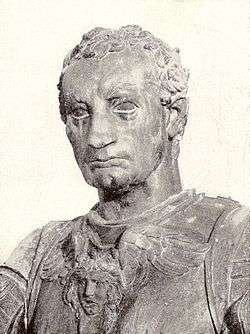Erasmo of Narni


Erasmo of Narni (1370 – January 16, 1443), better known as "Gattamelata" (meaning "Speckled Cat") was an Italian condottiero of the Renaissance. He was born in Narni, and served a number of Italian city-states: he began with Braccio da Montone, served the Papal States and Florence, as well as the Republic of Venice in 1434 in the battles with the Visconti of Milan.
He was the subject of Donatello's equestrian bronze sculpture in the main square of Padua, the same city over which he became podestà in 1437.
In Narni, the farmhouse in which Gattamelata was born bears a plaque reading "Narnia me genuit Gattamelata fui" ("I was born in Narni, I was Gattamelata").[1]
Biography
Erasmo of Narni was born in Narni, in Umbria, into a poor family. His condition led him to military life, initially under the Assisi lord[2] Cecchino Broglia. Later, together with his friend Brandolino Brandolini, he served under Braccio da Montone, one of the leading Italian condottieri of the 15th century,[3] lord of Perugia from 1416.
With Braccio, he participated in the conquest of Todi, Rieti, Narni, Terni and Spoleto, and, in 1419, in the battle of Viterbo against Muzio Attendolo.[3] At the Battle of L'Aquila (June 1424), Braccio's army was utterly defeated, and the condottiero himself killed; Erasmo led the remaining troops under the service of the Republic of Florence. In 1427 Pope Martin V hired him to regain the lands captured by Braccio da Montone.[3] Città di Castello fell in 1428, but Erasmo had moved to the northern Papal States to counter the rebellion of Imola, Forlì and Bologna. He entered in the latter in 1431, as the General Captain of the Papal States, and he also suppressed Antonio Ordelaffi's rebellion in Forlì.[3]
Mostly due of the late in wages,[3] Erasmo abandoned the Papal services in 1434. He was subsequently hired by the Republic of Venice. In the course of the war against the Filippo Maria Visconti of Milan, he defended Bologna and fought against Niccolò Piccinino. The latter defeated him at Castelbolognese on 28 August 1434, in a battle in which Gattamelata was wounded.[3] After a series of clashes and counter-manouvers, often lost by the anti-Visconti league, Gattamelata successfully defended Brescia and Verona in 1438. This granted him the title of General Commander of the armies of the Republic of Venice.[3] However, the following year the Venetians lost numerous cities, including Legnago, Soave and finally Verona itself. This defeat caused a strong criticism against Gattamelata.[3] The Republic called Francesco Sforza to fight along Gattamelata, and the two re-entered Verona on 9 July 1439.[3]
In 1440, while mustering a flotilla on Lake Garda, Gattamelata was struck by a cerebral hemorrage. He never fully recovered, neither led further substantial military campaigns. He died at Padua in 1443.
References
Sources
- Giovanna Baldissin Molli, Erasmo da Narni, Gattamelata, e Donatello: storia di una statua equestre; con l'edizione dell'inventario dei beni di Giovanni Antonio Gattamelata (1467) a cura di Giulia Foladore, Padua, 2011
- Joachim Poeschke, Reiterbilder und Wertesymbolik in der Frührenaissance – Zum Gattamelata-Monument Donatellos, in: Joachim Poeschke, Thomas Weigel, Britta Kusch-Arnhold (eds.), Praemium Virtutis III – Reiterstandbilder von der Antike bis zum Klassizismus. Rhema-Verlag, Münster 2008, ISBN 978-3-930454-59-4
- Raphael Beuing: Reiterbilder der Frührenaissance – Monument und Memoria. Rhema-Verlag, Münster 2010, ISBN 978-3-930454-88-4
- Antonio Menniti Ippolito, "Erasmo da Narni (Gattamelata)", in Dizionario Biografico degli Italiani, XLIII, Rome 1993, pp. 46–52.
External links
- Photos of the statue of Gattamelata
- Narni Town - information about Erasmo da Narni
- Equestrian Statues of the Renaissance